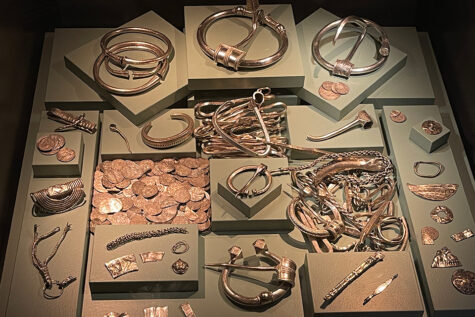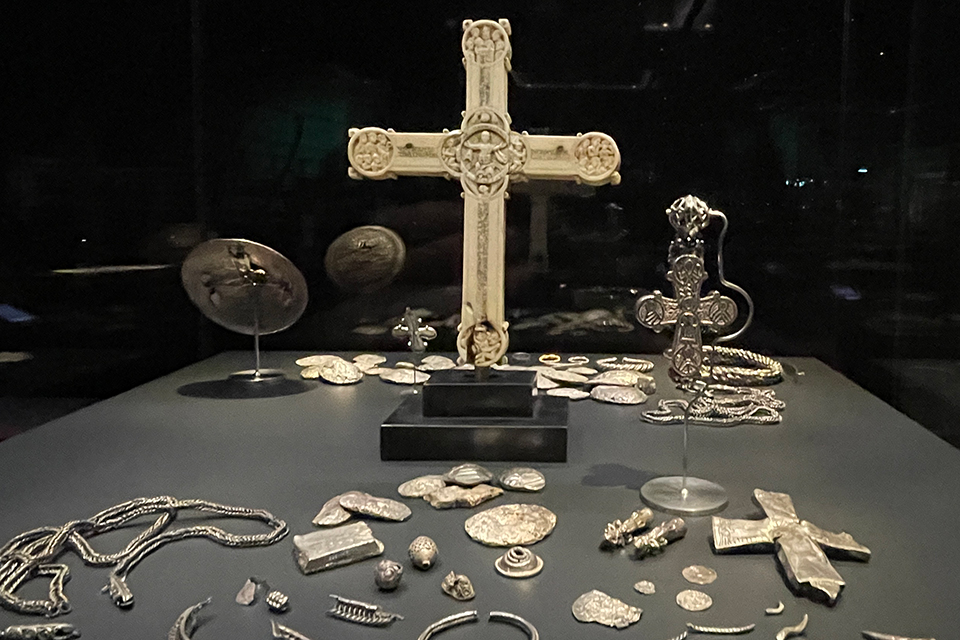Vikings dominate the heritage business of entertainment and populist politics in Scandinavia. This debate’s multiple nuances pervade a review of two major new exhibitions in Stockholm and Copenhagen, raising the question of how to impart knowledge of the Viking Age to the interested public.
Pirates in the Age of Populism. New Viking Exhibitions in Stockholm and Copenhagen
By Søren M. Sindbæk
With Keynote Comments by Howard Williams, Håkon Glørstad, Caroline Owman, Chris Tuckley, Hakon Glorstad, Matthias Toplak, and Frederik Svanberg.
Current Swedish Archaeology 2022
Open Access
ABSTRACT

A year ago, two new exhibitions featuring the Viking Age opened at Scandinavia’s leading museums in Stockholm and Copenhagen: the Swedish History Museum and the National Museum of Denmark. Meanwhile, Oslo is currently investing vast amounts of the income from their Government Pension Fund (also known as the Oil Fund) to bring together the famous ships formerly exhibited at the Viking Ship Museum at Bygdøj with the general Viking Age collection of the Museum of Cultural History. The project aims to be THE “Museum of the Viking Age”, and to open i 2026. Given the fabulous finds from Oseberg and Gokstad, this intention will likely be fullfilled. Meanwhile, though, we are left with the two competing “major” exhibitions dealt with in this paper.
The paper offers a astute review of the two exhibitions noticing their different approaches. In Stockholm, the setting is reminiscent of “a gift shop” offering countless glittering objects and bargains deriving from not just Birka and Gotland but the rich from Scania to the North, creating a myth of “Viking Age Sweden”. With no texts to hamper the visually enticing jewels and everyday objects, the visitor is invited to get the information from the touchscreens. A somewhat similar shopping trip experience is offered in Copenhagen, writes Sindbæk. However, although he notes the more dramatic slant of the Viking’s stories, this exhibition has been held captive by the need to show a motley of iconic treasures with no straightforward way for the visitor to engage with the why and where. Instead, a plain and bland appeal to “Join the Vikings” paired with the casual presentation of the usual national Viking heroes, Harold Bluetooth and Cnut the Great, let us skirt any serious reflection of what Vikings were. We are there to consume, not to reflect.
The Viking Age thus continues to be an object offered to the public for anodyne adulation. So what do these new exhibitions aim to achieve? Not instruction or education, but histotainment, it seems.
Thus, writes Sindbæk, “tourism is the surprisingly simple answer, as both museums have signalled. In this way, the exhibitions provide an insight into the adaptation that major museums have been moving towards over the 2010s to thrive in the age of populism, consumerism and privatization. The new exhibitions are thus a dry run for the heritage policies of the 2020s.” As Sindbæk notes: “The Viking Age is one of the world’s most well-known and popular historical brands, and the major Scandinavian museums are bustling with fascinating objects and captivating stories to present. However, is this enough for them to prosper? Will Vikings free museums – or turn them into captives?”. Sindbæk answers with acumen and insight: by offering a consumerist perspective on the Viking Age and also bluntly staging them as conservative and nationally focused exhibitions, we – the visitors – are reduced to a commonplace populace roaming the middle-of-the-road shopping avenue for yet another dazzling trinket, while experiencing the Viking Age as a refuge filled with adventure, freedom, romance, feel-good atmosphere and artistic authenticity. This begs a dilemma for serious historians and archaeologists struggling to impart well-researched insights into the complex World of the Vikings. In short, the curators chose feel-good entertainment rather than enlightenment.
The paper is followed up by several keynote comments discussing Vikingism, entertainment and knowledge production, the demise of the Viking Brand, white supremacy , New Public Management, and “retrotopia”. In the concluding answer to these comments, Sindbæk states his understanding of what museums’ role should be:
“Museums are particular social institutions charged with the remit to preserve and present significant artefact evidence from the past on behalf of the present and the future. For museums to fulfil their role, they need to be curated with a focus on this fact, and in a way which justifies continuing public approval and support. That is not a call for elitism, but for respon-sibility. If society – or capitalism, populism, or New Public Management – forces museums to operate fundamentally as commercial visitor attrac-tions, recent experience suggests that their other, more fundamental duties to society will risk being neglected”(p. 62)
A thought- provoking collection of essays and highly recommended.
Karen Schousboe
COMMENTS:
Public Viking Research in Museums and Beyond. By Howard Williams, University of Chester
There is No Essential Museum. By Caroline Owman, Nordiska Museet
The Viking Brand in Crisis? By Chris Tuckley, York Archaeological Trust
Populistic Exhibitions or Dedicated to a New Elite of Consumers? By Hakon Glorstad, Museum of Cultural history, University of Oslo.
Victims of Their Own Success – Academia and Public Research on ‘The Vikings’
By Matthias Toplak, Viking Museum Hedeby
Hip Viking Heritage. By Fredrik Svanberg, Nordiska Museet
This Belongs in a Museum. Reply to Comments
Søren Michael Sindbæk
FEATURED PHOTO
Viking Exhibition with spectacular objects albeit from the post-Viking Age. Copenhagen 2021 © Schousboe
